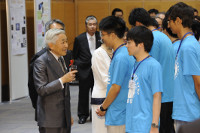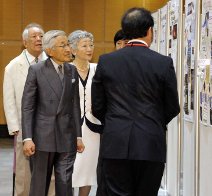 |
|
|
 |
From symmetry: Helium's shrinking bubble

Helium may be the second most abundant element in the universe, but on Earth it's a non-renewable resource. Physicists and engineers are working on ways to conserve and recycle this essential gas so it doesn’t just float away. |
Helium is the lifeblood of large particle accelerators. As the world’s supply dwindles, the particle physics community must take steps to preserve this precious commodity or learn to live without it.
At a couple of degrees above absolute zero, far colder than any living organism can survive, liquid helium stirs to life the largest particle accelerators in the world. It pulses through the veins of the Large Hadron Collider, following thousands of dipole superconducting magnets around a 27-kilometer ring. Flowing through magnets in Fermilab’s Tevatron, it helps jump-start subatomic particles on their way. These and other vital organs at dozens of labs around the world depend on helium to help them thrive.
Read more...
-- Calla Cofield |
 |
|
|
 |
|
 |
Start your dream from the Asia Science Camp

The Emperor of Japan talking to students attending Asian Science Camp. Photograph: 2009 ASC Organizing Committee
|
A total of 182 high school and university students from 19 Asian countries and regions relished the life-changing opportunity to learn directly from eminent scientists, including seven Nobel laureates in the fields of physics and chemistry: the Asian Science Camp 2009 was held from 2 to 8 August at Tsukuba International Congress Center, Ibaraki, Japan. It was hosted by the Heisei Foundation for Basic Science, KEK and the International Center for Elementary Particle Physics (ICEPP) at the University of Tokyo.
Read more...
-- Rika Takahashi |
 |
|
|
 |
From CHUNICHI Web
11 August 2009
<微聞積聞>日本に国際的装置を ナイジェル・ロッキャーさん カナダ国立素粒子・原子核物理学研究所所長
陽子加速器J−PARCが完成してニュートリノ実験など、世界から人が集まる国際プロジェクトが動きだした。海外の研究者から日本の物理学研究はどう見えているのか。カナダ国立素粒子・原子核物理学研究所のナイジェル・ロッキャー所長に聞いた。
Read more... (in Japanese) |
|
From Fermilab Today
7 August 2009
ARRA funds accelerate SRF, neutrino research
Fermilab’s efforts to develop superconducting radiofrequency technology and plans for a long-baseline neutrino experiment got a boost Tuesday with a new round of stimulus funds.
Read more... |
|
From CERN
6 August 2009
LHC to run at 3.5 TeV for early part of 2009-2010 run rising later
CERN's Large Hadron Collider will initially run at an energy of 3.5 TeV per beam when it starts up in November this year.
Read more... |
|
|
 |
ALCPG09 in Albuquerque

Poster for the Albuquerque ILC meeting |
Both the ILC detector and accelerator communities are dispersed all around the globe. We work together mostly at a distance though extensive use of modern communication tools. Nevertheless, we still must – and do – come together in classical face-to-face meetings to conduct our most important business. Presently, we hold two large meetings a year for the ILC physics, detector and accelerator scientists. These are very busy meetings, consisting of both general plenary sessions, as well as multiple parallel sessions on special topics. Our next such general meeting, organised by the American Linear Collider Physics Group (ALCPG), will be held at the University of New Mexico in Albuquerque, New Mexico from 29 September through 2 October 2009. Next month’s meeting will have special importance to both the ILC detector and accelerator efforts.
Read more...
-- Barry Barish
Director's Corner Archive |
 |
|
|
 |
Royal visitors

The Emperor and the Empress of Japan visited the Asian Science Camp (see story in this week's issue) and KEK last week. Here they are looking at posters made by students of the camp. Photograph: 2009 ASC Organizing Committee
|
arXiv preprints
0908.0876
Prospects for the study of the \stau-system in SPS1a' at the ILC
0908.1475
Looking for the Odderon in photon collisions
|
|

